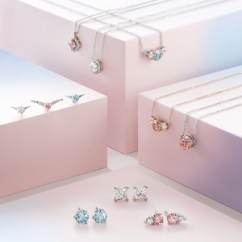Articles and News
Revised FTC Guidelines Remove “Natural” From Definition Of “Diamond” | July 25, 2018 (0 comments)

Washington, DC—The long-awaited revisions to the FTC’s Guides for the Jewelry, Precious Metals, and Pewter Industries (also called “Jewelry Guides” or “Guides”) have been released, sparking new anxieties about clear separation between mined and man-made diamonds. Left: a selection of man-made diamond jewelry from De Beers' new Lightbox division.
This is the first major overhaul of the Guides in more than two decades. While overall relatively little has changed in the realm of diamonds, there are a few small but signficant shifts. One that has some industry professionals up in arms: the word “natural” has been removed from the definition of diamond.
Neil Beaty, an AGS independent certified gemologist appraiser and owner of Colorado-based American Gem Registry, called it a victory for those who like scientific accuracy in language, but a blow to the natural diamond industry. “Until yesterday, the FTC definition of a diamond was: ‘A diamond is a natural mineral consisting essentially of pure carbon crystallized in the isometric system.’… Here’s the FTC’s new definition: ‘A diamond is a mineral consisting essentially of pure carbon crystallized in the isometric system.’ They’ve dropped the word natural.”
Sara Yood, senior counsel at the Jewelers’ Vigilance Committee who worked extensively on the Guides’ revision, confirms the change in definition. But she says ample protections remain in the revised law to prevent diamond growers from marketing their products as natural.
“Yes, the FTC did remove the word ‘natural’ from the definition of diamond,” she told The Centurion. “As they explain it, there are now other processes in which a diamond can be made, and therefore, having the word “natural” in the definition no longer made sense as they want all of the diamond provisions to apply to all kinds of diamonds, whether natural or lab-grown.”
Some revisions do give lab-grown diamond marketers a little more of what they want, especially in the use of the words "cultured" and "synthetic." Growers argued that consumers equate "synthetic" with "simulated," confusing diamonds with imitators like moissanite or CZ. The FTC took "synthetic" off the list of suggested descriptors for lab-grown diamonds, but stopped short of prohibiting its use, particularly in gemological or scientific terms. But it did rule that it's misleading to use the term to imply that a lab-grown diamond is not an actual diamond.
Another sticking point for the industry is the use of the word “cultured” to describe lab-grown diamonds. A significant portion of the revised Guides address this point—which, as Yood says, essentially remains the same, with some relaxation.
“The revised Guides state that the term cultured must be used with a qualifier, either ‘laboratory-grown’, ‘laboratory-created’, ‘[manufacturer name]-created,’ or ‘some other word or phrase of like meaning’. That last part is the open door: it allows marketers of laboratory-grown diamonds the leeway to use other terms to describe a laboratory-grown diamond, so long as the terms sufficiently disclose what the product actually is, and the disclosures are ‘clear, prominent, and understandable’,” she said.
But more importantly, the FTC retained the provision that prevents manufactured or artificially-produced products from being called “real”, “genuine”, “natural”, “previous”, or similar terms.
“Therefore, under the revised Guides, it would be deceptive to use any of those terms to describe a laboratory-grown diamond,” she told The Centurion.
JVC is working on a plain-language explanation of the changes for the industry, says Yood. Separately, Sarah Gorvitz, head of strategic communications for the Diamond Producers Association, says DPA is still reviewing the changes and won't have a complete analysis ready before next week. The Centurion will update both as information becomes available.
The revised Guides cover all aspects of precious metals and gems, not just diamonds, and there were some notable changes in other categories. For instance, anything below 10 karats was formerly not allowed to be called "gold" jewelry, as can silver less than .925. Both now can be called "gold" and "silver," respectively, as long as it's accompanied by a clear fineness description. Colored gemstones now have much stricter nomenclature definitions: names like "yellow emerald" and "green amethyst" no longer pass muster and composite gems such as lead-glass filled rubies can't be called "ruby" without a qualifier, something colored gem dealers have long advocated. Lab-grown colored gemstones must follow the same rules as lab-grown diamonds. And more treatments, such as dyed pearls, must be disclosed.
The complete revised Guides can be read here. The discussion of “cultured” diamonds begins on page 79. The revised definition of diamond is on page 114. Metals and alloys discussion begins on page 44; colored gemstone discussions begin on page 62.







